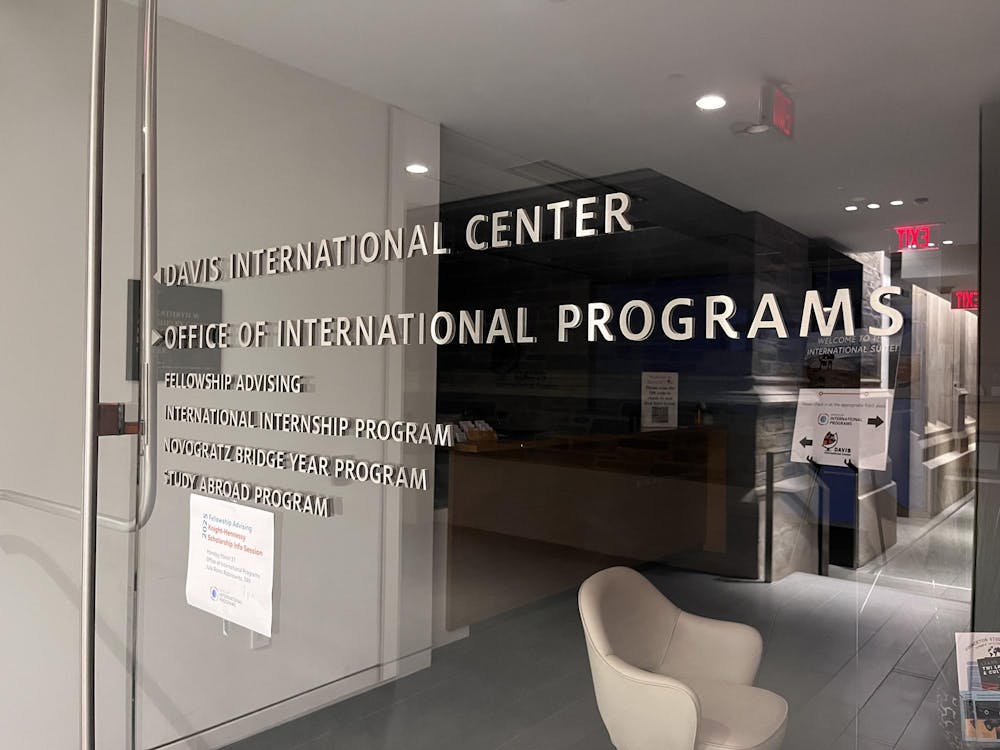Within the walls of Frist Health Center, old and new vie for the visitors’ attention. Old is represented by the structure of Eno Hall, still standing with its dusty brick facade and Greek engravings. The new is evident in everything else, from the winter garden to expansive window views.
The new health center opened on Jan. 31 as part of a wave of construction that has transformed Princeton’s central campus. But unlike the more starkly modern art museum or Hobson College, where the original structure was torn down and is being completely rebuilt, Frist Health Center was constructed around the old Eno Hall’s skeleton. The similarity of the buildings’ purposes is apparent: where Eno Hall once housed one of America’s first scientific psychology departments, Frist Health Center has been positioned at the forefront of the University’s investments in student mental health services.
Prior to Eno Hall’s completion in November 1924, Princeton’s fledgling Department of Psychology was housed in cramped quarters in Nassau Hall. The new laboratory was designed in the collegiate gothic style by architectural firm Day & Klauder and was a rare jewel among universities, boasting state-of-the-art equipment like a “sound-proof chamber” and “rooms designed for the investigation of animal behavior.”
“The building whose cornerstone is about to be laid is the first laboratory in this country, if not in the world, dedicated solely to the teaching and investigation of scientific psychology,” proclaimed then-Head of the Psychology Department Howard C. Warren GS ’91 at a ceremony conducted that January.

Construction of Eno Hall begins in 1924.
The Daily Princetonian
Balancing historical styles while embracing progress is familiar territory for University Architect Ron McCoy GS ’80, who has worked on Yeh and NCW Colleges and the new art museum.
“What we try to do is ensure that balance between a kind of memory and a vitality of new vision,” McCoy said, while also “respecting those things that are the most beautiful parts of the campus.”
Through student engagement meetings with undergraduate and graduate student governments, McCoy learned that students preferred the McCosh Health Center’s collegiate gothic design.

By integrating old and new, McCoy was able to “incorporate that [student] attachment to a piece of historic campus” within the health center’s plans. Today, the presence of Eno Hall within the health center stands as testament to this student desire. Visible still is the original engraving over Eno’s back door: ΓΝΩΘΙ Σ’ΑΥΤΟΝ, or “Know Thyself.”
Although the Department of Psychology has long since vacated Eno Hall, the building has found new life through its recent renovation. The architectural firm WRNS Studio was chosen to work on the project after an interview and committee process chaired by President Eisgruber ’83, according to McCoy. At 74,670 sq ft, their design more than doubles the space previously available at McCosh. According to their website, the project is meant to be a “welcoming campus amenity” that incorporates University Health Service’s (UHS) branches with health education.
“We wanted to avoid a clinical, sterile vibe that might be off-putting,” said Janet Finnie ’84, director of UHS.
Frist Health Center features large operable windows, adjustable ceiling fans, and natural colors in its design. It also uses a Dedicated Outdoor Air System (DOAS) intended to improve both air quality and visitor experiences while maximizing efficiency. Many of these aspects were requested by attendees at student engagement meetings during the planning process, according to Director of Communications for Facilities Karen Fanning.

“Inside the building, you’re always aware of daylight, and daylight is so important in terms of health and wellness,” McCoy explained. “The large windows are just fantastic vistas out to that daylight.”
Some students agree that the health center’s eye-catching and “aesthetically pleasing” design have improved the experience of receiving care.
“Especially in the waiting area, it wasn’t an anxious space,” Gwennie Nellis ’29 told The Daily Princetonian. “It felt like I was there to be helped and that it was going to be a positive experience because the environment already felt positive and welcoming.”
The Frist Health Center has particularly sought to improve Counseling and Psychological Services. As Finnie explained, offices for counselors at McCosh were limited, requiring awkward schedules and virtual sessions. The new health center has enough offices for every counselor and more exam rooms to accommodate patients, many of which are within the old Eno Hall structure.
This new architecture speaks to the concerns of many students about accessing mental health care on campus.
“My hope is that the pleasantness of the space will encourage students who might be ambivalent about seeking services to reach out,” Executive Director of UHS John Kolligian Jr. said.
In addition to its health facilities, Frist Health Center boasts recreational and lounge space. The design is meant to invite students to “study, socialize, and recharge” while simultaneously “[destigmatizing] access to care,” according to WRNS Studio. A central fixture of the health center is its atrium, which is partially made of Eno Hall’s facade with the “Know Thyself” engraving.
“I cannot tell you how many times students enter the center, stand in the atrium, seem struck by the architecture and space, then slowly rotate 360 degrees as they take it all in,” Kolligian said.
“I usually don’t really like [modern architecture],” Nellis said. “But I think they did a good job with it.”
Unlike its predecessor, much of Frist’s square footage is intentionally open and integrated into the outdoors. Whether through natural light or greenery, the health center’s “biophilic” design is seen inside and outside the building. McCoy explained that Frist will eventually be surrounded by gardens once the construction around it has finished. The large windows intentionally look out to the plant-filled Isabella McCosh Garden — a cloister garden — and, eventually, the new surrounding landscapes.
“The McCosh Infirmary had a beautiful courtyard garden, kind of quiet, kind of subtle, kind of private, and we wanted to respect that legacy and bring in a new cloister garden, but make it more accessible and a place to hang out,” McCoy said.
Lucia Greenhouse ’29 expressed her appreciation of the health center’s greenery. “I saw [the Isabella McCosh Garden] as I walked in, and you can see the plants from outside, too,” she said. “That made me happy.”
When McCoy guides architects on designing buildings for the University, he references three primary “salient beauties” of campus: the body moving through space, craft and materiality, and the landscape.
“If each generation pays attention to those respectfully,” McCoy said, “and [if] every generation has a good memory of the history of the campus, even though they’re adding something, they’re contributing something new to that history.”
Lucia Zschoche is a contributing writer for Features and Archives for the ‘Prince.’








